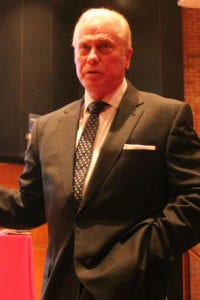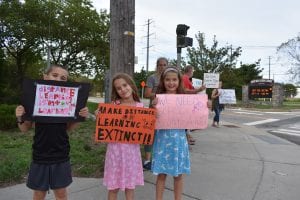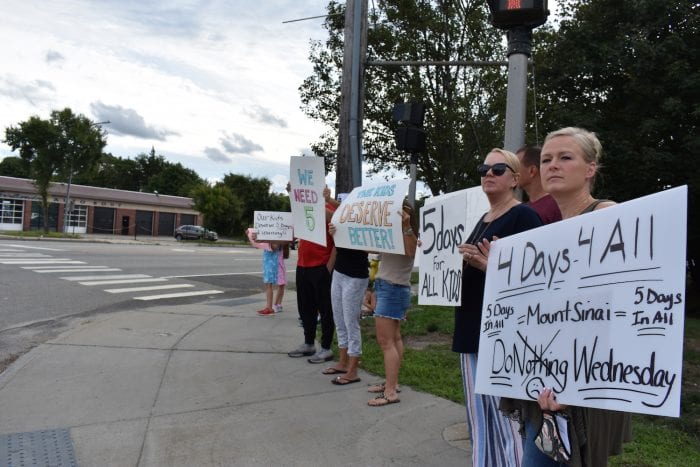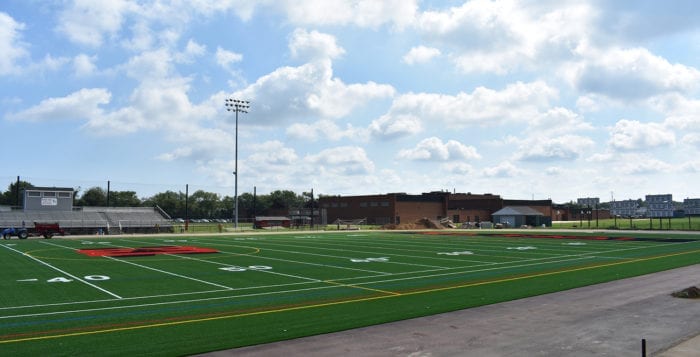As the impending start to the school year closes in, some parents in districts like Mount Sinai are trying to close what they perceive as gaps in schools’ upcoming learning programs.

A small group of Mount Sinai residents consisting of parents and a few of their children protested at the school campus entrance on Route 25A Monday, Aug. 31, arguing their school district’s current reopening plans could lose students days’ worth of instruction time. Meanwhile, district officials allege plans will likely change in the future, and they are doing their best to move to a system for five-day full-time instruction for elementary students and more in-school days for secondary students.
Elle Bee, who has three students in the district — a kindergartener, elementary and middle schooler — said the district has not been communicative enough with her and other parents about their concerns, especially over what the district plans for Wednesdays. They also claimed that their questions and concerns have not been fully answered by the school administration.
“We want actual distance learning,” Bee said. “We would like to return to four days or five days in school.”
Current district plans have all students out of school on Wednesdays in order for the custodians to fully sanitize each building. Teachers will be using that time to communicate with students, especially the 50-odd children per building that will be learning remotely full time, though students will still be required to log on to the school’s Google Classroom. Parents at the small protest said that if this standard lasted all year it would result in students losing upward of 40 days of learning, which would be less than New York State requirements for the total number of instruction days of 140.
Kevin Mathers, who has a seventh-grader in the middle school, said he finds it absurd that the district will not even attempt at least a true remote experience on Wednesday.
“Any plan that includes not teaching on Wednesdays is a nonstarter,” he said.
Superintendent Gordon Brosdal said in a phone interview there will be some instruction on Wednesdays. Teachers are going to be constructing videos and lessons for both that day and for all remote days. Instructors are also supposed to touch base with all the remote students whose parents chose to keep them at home. Teachers, he said, are working at the max extent that their contracts call for, and that they hope by the end of September they will be able to change it to include Wednesdays for full instruction in the elementary school and in cohorts in the high school.
“When teachers teach four days a week, when are they going to do that remote learning and ask each student, ‘How are you doing?’” the superintendent said. “When can parents reach [teachers] and visit teachers during office hours? That’s what Wednesdays are for.”
Still, this isn’t enough for the parents who stood along Route 25A. Some parents asked why the district wasn’t mandating that every teacher livestream their classes.
Brosdal said there were concerns amongst teachers, based on previous news reports, that people could break onto these livestreams and harass both students and the teachers. Though the district is installing around 160 cameras in classrooms for the purpose of broadcasting lessons for those either creating videos or, in some cases, livestreams.
Parents also complained about plans for students on buses. They said they were originally told buses would be at 50% capacity and only siblings could sit on the same seats. They argue this was changed to now allow up to 44 seats with even nonfamily members sitting together.
“They’re going to have to wear masks full time, even with guards around their desks, so how are you shoving them onto buses like sardines in a can?” Bee said.

Brosdal confirmed that buses could be at more than 50% capacity, though it’s all dependent on how students are either dropped off by their parents or walk to school. The district is limited in the number of buses their contracted company First Student has, and that it would cost the district upward of $80- to $90,000 to request that even one new one be built. Still, he is confident that buses wouldn’t be at far less than their max capacity.
Some parents were especially concerned with their students receiving special education. Alexandria Hoehl said she had four children in Mount Sinai who receive special services in the district, and she was concerned they would not get the five days of one-on-one attention they need.
My kids “are going to miss more class time when they’re in school to meet the needs of their services they get — like physical therapy, occupational therapy — which are now being squeezed into a shortened amount of time,” she said. “With my oldest, with only being in school two days, they’re going to try and fit five days of services into two days.”
Brosdal said the school is required to follow each special needs student’s individualized education program. The special-ed students will be receiving teaching four days a week and remote learning one day a week, according to the district’s plan.
Though the superintendent said he wants as much in-school instruction as possible, the problem, he said, is space, especially concerning the high school. With 800 students plus staff, the superintendent said it would be impossible to have all students learning in person four days a week and keep them distanced as required by New York State.
The high school, he added, is also very problematic when students have to move from one classroom to another between periods, as the school is designed so several hallways are linked by one larger hallway. Looking at pictures from schools out of state with kids flooded into hallways with minimal distancing, as well as news like SUNY Oneonta’s recent shutdown because of escalating COVID-19 cases on campus, Brosdal said the district needs to be careful if it ever wants to open up more broadly.
But for some parents, the possibility that things could change in a month’s time is not enough reassurance. Bee said that the virus infection rate in New York remains low, but “it’s never going to be zero — why shouldn’t we start off now and pull it back if the numbers increase, if they increase, because we simply don’t know.”







